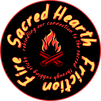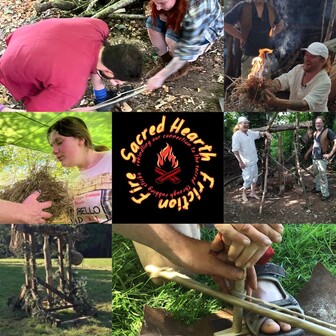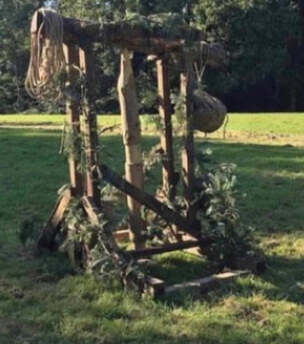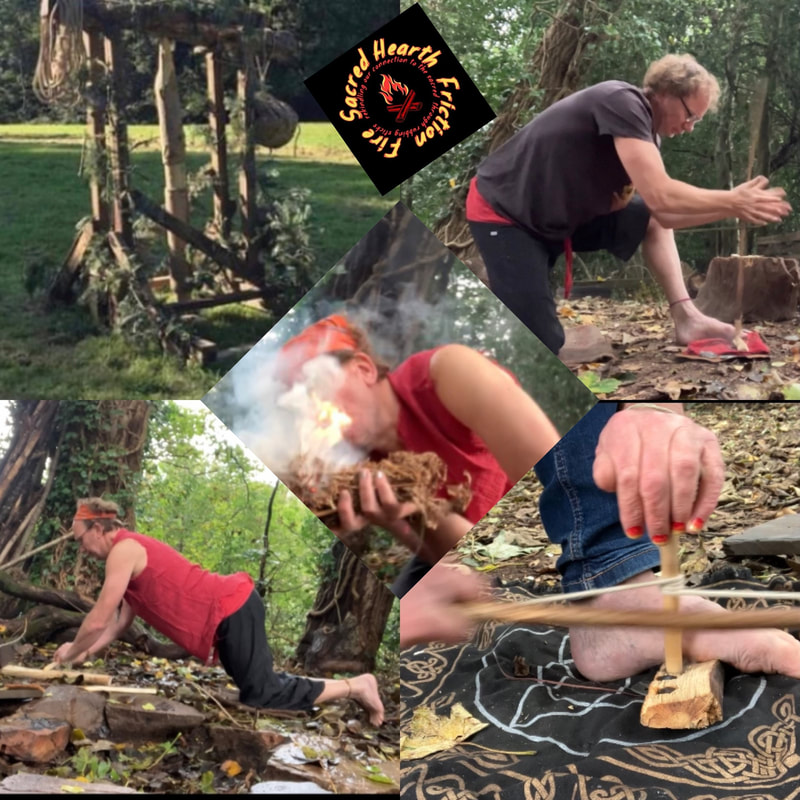Rekindling our connection to the sacred through Rubbing Sticks
SHFF is fully inclusive and embraces people from all walks of life; abilities; backgrounds and celebrates diversity! Neurodivergent and LGBTQ+ friendly.
SHFF encourages and champions communal fire welcoming - rubbing sticks does not have to be a solo challenge but a communal welcoming so yes everyone can get involved in rubbing sticks in some way ! It can be inclusive!
SHFF encourages and champions communal fire welcoming - rubbing sticks does not have to be a solo challenge but a communal welcoming so yes everyone can get involved in rubbing sticks in some way ! It can be inclusive!
|
SHFF has been exploring the folk lore, stories, mysticism and sacredness of fire and honouring the ancestral fire through rubbing sticks since 2014.
SHFF is now focussing more on encouraging communal fire welcoming ; sharing knowledge and skills of rubbing sticks for use in sacred/holistic practice - which is very different to bushcraft friction fire - and sharing the SHFF approach and philosophy. In 2024 I hope to participate more within communal ritual and continue to share my approach to welcoming the ancestral fire in a holistic way. |
|
|
Ritual fire was once part of our cultural heritage within British Isles- Neid Fire has been used for hundreds of years until 19th century - mostly erased from the ancestral memory - thankfully documented by 19th century historians.
SHFF is now focussing on guiding people within the British Isles to welcome fire for use in their own sacred practice and to further delve into the Neid Fire practice and share with others so Neid Fire can once again become part of our cultural heritage. |
|
The website was first put together in 2016 and has recently had a tidy up and includes (click on links) :
|
About SHFF
|
SHFF is run by Ian who has honed his fire by friction skills since 2014 over many hours practicing and experimenting, and researching and soaking up the stories and folklore. Ian has participated in many different types of practices\retreats over 20 years bringing that experience into his approach.
Find out more about Ian here - and find out more about my offerings |
|
Ian is also continuing to explore his own connection with fire which is ever evolving - see these blog posts :
The Ancestral Fire
Exploring my connection with fire.
The Ancestral Fire
Exploring my connection with fire.
Story and myths and deepening our connection
You could say we were created from fire, or as Ian likes to say "forged from fire" - our evolution and all the advancements we see and use today would not have been possible without fire! A key part of the SHFF way is to honour the ancestral fire and reconnect people to fire and to practice in a respectful and honouring way to nature and the land, especially in a world where most people take things for granted.
Ian likes to weave in old stories and folklore.. there are many myths and legends from around the world. Many of them have a common theme of how fire is hidden within trees and the only way to coax the fire out is through rubbing sticks together.
I have added Stories from around the world here and adapted my own story.
You could say we were created from fire, or as Ian likes to say "forged from fire" - our evolution and all the advancements we see and use today would not have been possible without fire! A key part of the SHFF way is to honour the ancestral fire and reconnect people to fire and to practice in a respectful and honouring way to nature and the land, especially in a world where most people take things for granted.
Ian likes to weave in old stories and folklore.. there are many myths and legends from around the world. Many of them have a common theme of how fire is hidden within trees and the only way to coax the fire out is through rubbing sticks together.
I have added Stories from around the world here and adapted my own story.
On a practical level, this site focusses on the 4 methods that Ian uses i- and all of these can be done together with others....
Neid Fire
Fire Plough UK - From 2020 Ian has been passionate about sharing the knowledge he has gained with the fire plough which is a very primal way of coaxing fire. There are few in-depth resources on fireplough
Bow Drill
Hand Drill
and touches upon the other friction methods and a brief history of methods.
The website also includes methods used for welcoming fire as part of ritual used by different traditions. The way friction fire is used differs widely between bushcraft and survival practitioners, indigenous peoples, ritual\ceremonial practitioners, "primitive skills" practitioners and my own approach.
Ian sees the art of rubbing sticks as a ritual in itself and brings in awareness and intention; acknowledging where materials have come from, not taking fire for granted and being thankful to the source of fire and to our ancestors for discovering these techniques.
Neid Fire
Fire Plough UK - From 2020 Ian has been passionate about sharing the knowledge he has gained with the fire plough which is a very primal way of coaxing fire. There are few in-depth resources on fireplough
Bow Drill
Hand Drill
and touches upon the other friction methods and a brief history of methods.
The website also includes methods used for welcoming fire as part of ritual used by different traditions. The way friction fire is used differs widely between bushcraft and survival practitioners, indigenous peoples, ritual\ceremonial practitioners, "primitive skills" practitioners and my own approach.
Ian sees the art of rubbing sticks as a ritual in itself and brings in awareness and intention; acknowledging where materials have come from, not taking fire for granted and being thankful to the source of fire and to our ancestors for discovering these techniques.
Side note: You are welcome to reference material / research on SHFF website/channels in your own websites/articles as my goal is to share knowledge! Please acknowledge Sacred Hearth Friction Fire, if this is where you obtained your research from. Ian also tries his best to reference other people's work and research.
Legalities \ Good Practice
A final note on knife laws, lighting fires and collecting materials. Please be aware of any local laws around knives and also for lighting fires and use good common sense (see this link regarding knife law in the UK,) Please also use discretion and awareness when collecting materials - see blog post here.
Regarding fires - only light fires where you know you are allowed to do so. If you don't have a fire bowl to hand (you are in the wilds!), then build your fire on bare earth, dig a fire pit if you need to, and if digging turf - replace the turf before you leave. Be especially aware when lighting fires in woodland (especially pine forests) e.g. roots can potentially catch light (smoulder for hours afterwards) and the fire can spread under ground - don't build fires where there is an extensive root system close to the surface. Similarly if building a fire in grassland (especially if the grass is dead and dry) - dig a pit and line the edge with stones and cut back\flatten long grass in the vicinity. Only build a fire small enough for your use, be aware of your surroundings, never leave a fire unattended, and always put it out before you leave - dowse the embers with water to be sure - cover up the remains with earth - and always leave no trace!
A final note on knife laws, lighting fires and collecting materials. Please be aware of any local laws around knives and also for lighting fires and use good common sense (see this link regarding knife law in the UK,) Please also use discretion and awareness when collecting materials - see blog post here.
Regarding fires - only light fires where you know you are allowed to do so. If you don't have a fire bowl to hand (you are in the wilds!), then build your fire on bare earth, dig a fire pit if you need to, and if digging turf - replace the turf before you leave. Be especially aware when lighting fires in woodland (especially pine forests) e.g. roots can potentially catch light (smoulder for hours afterwards) and the fire can spread under ground - don't build fires where there is an extensive root system close to the surface. Similarly if building a fire in grassland (especially if the grass is dead and dry) - dig a pit and line the edge with stones and cut back\flatten long grass in the vicinity. Only build a fire small enough for your use, be aware of your surroundings, never leave a fire unattended, and always put it out before you leave - dowse the embers with water to be sure - cover up the remains with earth - and always leave no trace!
Bow Drill - Fire Drill - Hand Drill - Friction Fire - Sacred Fire - Origin of Fire Story - Fire Ritual - Ancient Fire Lighting - Fire Churn - Neid Fire - Force Fire - Tein-Éigin - Fire Churning - Demonstrations - Pagan Friction Fire - Heathen Friction Fire - Bristol - South West - UK
Site Last Updated: 11th March 2024
Site Last Updated: 11th March 2024





